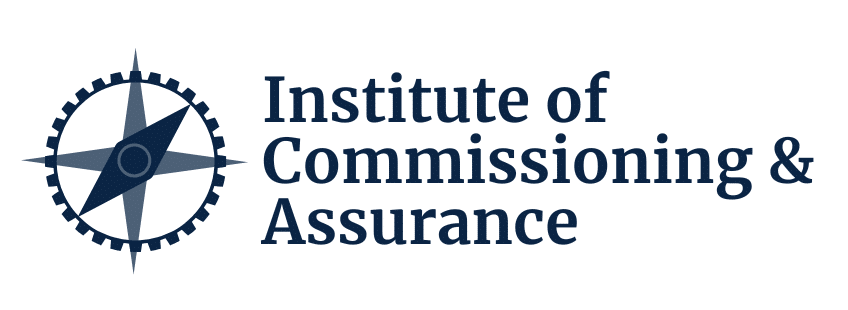Think of commissioning as piecing together a complex puzzle. Each piece of the puzzle represents a different system or component within a project. These pieces must interlock perfectly to form a complete picture—your project. Missing or incorrectly placed pieces can disrupt the entire image, leading to gaps or misalignments in both your puzzle and your project.
Commissioning ensures that every piece is scrutinized, adjusted, and placed correctly, ensuring a seamless fit and a complete project. As the last piece is set in place, the project’s full potential is realized, creating a cohesive, functioning whole. In this way, commissioning brings all the puzzle pieces together, ensuring no piece is overlooked, and the final picture is both complete and successful.
Let’s dig into this a little bit more.
Think of your project commissioning as an iceberg.
The tip of the iceberg—the part people mostly focus on—is on-site testing. This is the only part visible above the waterline and represents maybe 20% of the activities that make up commissioning. But below the surface, there is a much larger portion, and this is where 80% of the effort is required to build your commissioning puzzle.
The problem is, many projects focus only on what’s visible above the waterline, missing the 80% of the puzzle pieces below the surface. When you don’t have all the pieces, it’s tough to complete your project successfully.
So, what are the commissioning puzzle pieces that often get missed because they’re not seen below the waterline?
- Commissioning Starts Early
Commissioning starts at the beginning of the project during your Front-End Engineering Design (FEED) processes. Commissioning input is required during design processes—preliminary design reviews and detailed design reviews. Operations and commissioning teams need to be involved to assess both the operability and “commissionability” of the designs. This is where lessons learned from the end of previous projects are applied to the next project.
This is also when the commissioning strategy is developed.
This strategy includes how the project will be systematized, tested, and commissioned at the end. So, your FEED process is where the commissioning strategy starts to take shape.
- Procurement with Commissioning in Mind
Commissioning input is critical during procurement processes, particularly when creating and writing procurement packages to award contracts for design and construction. Commissioning involvement ensures design and construction activities align with the overall commissioning strategy. It’s like a puzzle. There are lots of pieces from both design and construction that must come together at the end. Commissioning input helps ensure all pieces will be available and ready for commissioning, avoiding gaps at project completion.
- Mechanical Completion Packages
When construction contracts are being prepared, it’s important to define your mechanical completions and systematize the project. You need to create mechanical completion packages to define your construction completions and ensure quality assurance and quality control (QA/QC) processes during construction align with commissioning requirements.
- Equipment Procurement & Testing
As equipment is procured, it’s essential to ensure it’s correctly specified for the required testing, both at the factory and on-site. Define Factory Acceptance Testing (FAT) and Integrated Factory Acceptance Testing (IFAT) in contracts to make sure off-site testing aligns with your expectations for on-site testing. This helps catch issues early, avoiding risks later.
- Collaboration Between Construction & Commissioning
Close collaboration between construction and commissioning teams is vital. Together, they must build an integrated construction and commissioning schedule to ensure a smooth handover from construction to commissioning.
- Commissioning Management System Setup
Early in the project, the commissioning management software needs to be selected and set up. This software defines how the project will be sequenced and how design, construction, and commissioning activities will come together. It serves as a guide for all teams involved, ensuring a clear path from start to finish.
- Gated Commissioning Workflows
As construction is completed, you need to define the milestones for each system. These include pre-commissioning, commissioning, and startup to build the overall plant process.
- Pre-Commissioning Checklists & Procedures
Finally, pre-commissioning checklists and commissioning procedures are the pieces of the puzzle most people are familiar with. This testing takes place at the end of projects, but it’s just the tip of the iceberg. There’s much more that lies below the surface, comprising the bulk of the commissioning puzzle.
- System Handover & Operational Readiness
Your commissioning strategy should also define system startup, handovers, and operational readiness. This ensures that the operations team is prepared for ongoing operations and maintenance of the new assets. Documentation, training, and readiness of the operators are essential for a successful handover.
There are many pieces to the commissioning puzzle. It’s the commissioning manager’s role to put this million-piece puzzle together at the end of a project. If you focus only on the tip of the iceberg, you’ll always be scrambling to find the missing pieces at the end.
How do you get a complete picture for commissioning and focus on all the pieces required?
The best place to start is with the ICA Global Commissioning Standard, available in the members’ area of the Industrial Commissioning Association. Visit icxa.net to get your copy and help ensure your project’s success.


Recent Comments